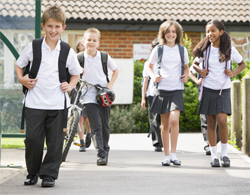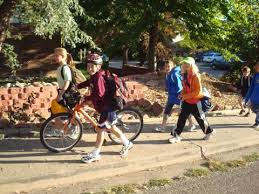
A new school year is about to get under way. To help get Liverpool and Macarthur parents ready, the South West Voice has joined forces with South Western Sydney Local Health District to look at three vital issues: how to survive the first day of school, lunchbox choices and the importance of promoting healthy life-long habits by encouraging children to walk or cycle to school:
The first day of school is the beginning of an exciting adventure but it can also be a little scary for many youngsters.
South Western Sydney Local Health District Director of Community Paediatrics Dr Roger Blackmore said children who have been prepared for the first day of school are much more likely to be positive and confident about the big day.
For those children heading off to school for the first time, early preparation can make a big difference to how a child will react to spending a full day at school.
“For most children, kindergarten is an exciting and wonderful year. However, the confidence, adaptability and stamina of first timers are challenged in the new school environment,” Dr Blackmore said.
“Children will find themselves in an unfamiliar environment with more people, bigger buildings, new routines and demands, different language and cultures and being away from their parents for longer periods of time.
“Parents can help a child to be more comfortable with their new surroundings beforehand. They can visit the school and explore its layout, talk about previous orientation visits and what will happen on the first day,” Dr Blackmore said.
“Discussing questions and concerns is better than letting both parents and children build up a fear of the unknown.
“Some children react to the challenges with immature or dependent behaviour such as tantrums, shyness or wetting pants. This can be confusing and embarrassing for the child, siblings and parents. Support them with reassurance, confidence and patience.
“Persisting problems should receive professional support, starting with the school staff,” Dr Blackmore said.
With support from their parents and teachers most children start school well. However Dr Blackmore said about 10 per cent of children are vulnerable in their development and may not fit in and adjust as well.
“Some children have developmental disabilities, affected speech and language, hearing or vision and these need to be discussed with the school principal before enrolment,” Dr Blackmore said.

As families prepare for the new school year, they are being reminded to give children healthy lunchbox choices.
South Western Sydney Local Health District’s (SWSLHD) Healthy Children’s Initiative Manager, Leah Choi, said small changes and extra care when packing lunches and snacks can be the key to positive change to guard against overweight and obesity in school children.
“Healthy habits formed early in life can stick with a person beyond childhood, so there’s no better time to teach children healthy food habits than now,” Ms Choi said.
“What’s more, obese adults who were overweight as adolescents tend to have a higher risk of weight-related diseases including cancer, diabetes and high blood pressure.
“Eating healthy food can help children concentrate at school and can give them the right type of energy for their day.’’
Ms Choi suggested making simple changes like making sure you pack food that comes in its own packaging, like apples, sultanas, nuts, grapes or boiled eggs rather than packaged chips or sugar-laden muesli bars.
“The less manufactured the food, the higher the chance of it being healthier; and probably cheaper at the check-out as well,’’ Ms Choi said.
“Considering children often consume up to 50 per cent of their daily calories at school, it’s important that their lunchbox is filled with yummy, healthy choices.
“Try incorporating fruit and vegetables wherever you can, whether it’s grated carrot or lettuce on a sandwich, or homemade muffins with dried fruit, carrot, zucchini, banana or pumpkin.”
Ms Choi said it’s also important to remember appropriate serving sizes.
“Fruit is great, but not if it’s overdone and a child ends up having 10 pieces. Parents should focus on appropriate serving sizes and on food that is balanced and gives kids energy throughout the day, like healthy carbohydrates and whole grains that are really important for longer lasting energy.
“Minimise extra snacks that can be tempting to kids at the supermarket like muesli and fruit bars: they are often full of sugars, which can also harm their teeth.”
*Watch a video featuring Ms Choi’s top lunchbox tips at: http://youtu.be/My-5hC1J0mw

Parents are being encouraged to give their kids an active start to the school year by helping them walk or cycle to and from school.
South Western Sydney Local Health District Acting Health Promotion Director, Liz Millen, said setting healthy examples and encouraging children to be active when they were young promoted healthy life-long habits.
“Regular physical activity bring children so many health benefits, like building strong bones and muscles, maintaining a healthy weight, improving balance and posture, maintaining and developing flexibility and boosting confidence and self-esteem,” Ms Millen said.
“The biggest hurdle is often finding time, but with a little bit of planning parents can help turn new activities into regular, beneficial habits.
“Children should get at least 60 minutes of physical activity every day.
“This doesn’t need to occur all at once, it can be accumulated throughout the day with a combination of moderate to vigorous activities,” she said.
The 2014 Active Healthy Kids report shows only 19 per cent of Australians aged five to 17 meet the recommended Australian physical activity guidelines.
While 64 to 85 per cent of children participate in some form of organised sport, only 35 per cent of six to seven year olds and 39 per cent of eleven to twelve year olds travel to school using active transport at least once a week.
Evidence suggests active commuting provides children with a number of health benefits including increased physical activity, six to eight times higher energy expenditure and three to nine times higher levels of cardiovascular fitness.
“Many adults remember walking or cycling to school, but today, most primary school children travel to and from school by car, even if they live within walking distance of their school.
“For families who live some distance from school, try parking the car a good distance away from the school and walk the rest of the way, or walk to the bus stop instead of driving,” she said.
Ms Millen encouraged parents to consider whether walking or cycling to school was possible and safe.
“Children should always wear a helmet when riding their bike, and if walking, children under 10 should hold an adult’s hand when around traffic and when crossing the road.
“If it’s not possible for your child to walk or ride a bike to school, consider some after-school activities like team sports or even encourage them to kick a ball around with other local kids,” she said.
